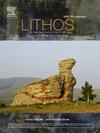Reconstruction of Cretaceous-Eocene arcs along the southern Asian margin under Neo-Tethyan subduction
IF 2.9
2区 地球科学
Q2 GEOCHEMISTRY & GEOPHYSICS
引用次数: 0
Abstract
The distribution and episodic magmatism of the southern Asian continental arc since the Cretaceous remains unclear. Here, we systematically compiled zircon U![]() Pb ages and Hf isotopic data sets, including magmatic rocks exposed on surface, detrital zircons from erosion of magmatic rocks, and xenocrystal zircons entrapped by Cenozoic volcanics from deep magmatic rocks, to elucidate these questions. Magmatic flare-up at 140–110 Ma occurred from central and northern Lhasa through eastern Tengchong to Shan Scraps, which resulted from the combination of diachronous closure of Bangong-Nujiang Tethys Ocean and subduction of a consolidated Neo-Tethys Ocean from Lhasa to Shan Scraps. During late Cretaceous-Eocene times, an extended Neo-Tethyan continental arc was built on the southern Asian margin from southern Lhasa, through Tengchong-Shan Scarps to Sumatra, excluding West Burma. The continental arc shows spatiotemporal variations in magmatism across different sections. Magmatism in eastern southern Lhasa and Sumatra is dominated by juvenile crust growth with flare-ups at 105–85 Ma and 65–45 Ma. In contrast, magmatic flare-ups at 75–45 Ma and ancient crust reworking are recorded in western southern Lhasa, Tengchong, and Shan Scraps. The spatial and temporal variations in magmatic flare-ups of Neo-Tethyan continental arc are probably related to asynchronous rollback of the Neo-Tethyan slab under different sections. During late Cretaceous-early Paleocene times, the multi-stage changes of Neo-Tethyan slab dip caused asynchronous extension-compression cycles on southern Asian continental margin.
Pb ages and Hf isotopic data sets, including magmatic rocks exposed on surface, detrital zircons from erosion of magmatic rocks, and xenocrystal zircons entrapped by Cenozoic volcanics from deep magmatic rocks, to elucidate these questions. Magmatic flare-up at 140–110 Ma occurred from central and northern Lhasa through eastern Tengchong to Shan Scraps, which resulted from the combination of diachronous closure of Bangong-Nujiang Tethys Ocean and subduction of a consolidated Neo-Tethys Ocean from Lhasa to Shan Scraps. During late Cretaceous-Eocene times, an extended Neo-Tethyan continental arc was built on the southern Asian margin from southern Lhasa, through Tengchong-Shan Scarps to Sumatra, excluding West Burma. The continental arc shows spatiotemporal variations in magmatism across different sections. Magmatism in eastern southern Lhasa and Sumatra is dominated by juvenile crust growth with flare-ups at 105–85 Ma and 65–45 Ma. In contrast, magmatic flare-ups at 75–45 Ma and ancient crust reworking are recorded in western southern Lhasa, Tengchong, and Shan Scraps. The spatial and temporal variations in magmatic flare-ups of Neo-Tethyan continental arc are probably related to asynchronous rollback of the Neo-Tethyan slab under different sections. During late Cretaceous-early Paleocene times, the multi-stage changes of Neo-Tethyan slab dip caused asynchronous extension-compression cycles on southern Asian continental margin.
新特提斯俯冲下南亚边缘白垩纪-始新世弧的重建
白垩纪以来南亚大陆弧的分布和幕式岩浆活动尚不清楚。本文系统整理了地表露露的岩浆岩、岩浆岩侵蚀形成的碎屑锆石、深部岩浆岩中新生代火山圈闭的异晶锆石等锆石UPb年龄和Hf同位素数据集,对上述问题进行了阐述。140 ~ 110 Ma岩浆爆发发生在拉萨中北部经腾冲东部至山边疆区,这是班公-怒江特提斯洋的历时性闭合和拉萨至山边疆区合并新特提斯洋的俯冲共同作用的结果。晚白垩世—始新世,在南亚边缘从拉萨南部,经腾冲山崖至苏门答腊(不包括西缅甸),形成了一条延伸的新特提斯大陆弧。大陆弧在不同剖面上表现出岩浆活动的时空变化。拉萨南部东部和苏门答腊的岩浆活动主要是在105 ~ 85 Ma和65 ~ 45 Ma爆发的幼年地壳生长。拉萨南部西部、腾冲和陕西地区则记录了75 ~ 45 Ma的岩浆爆发和古地壳改造。新特提斯大陆弧岩浆爆发的时空变化可能与新特提斯板块在不同剖面下的不同步回滚有关。在晚白垩世-早古新世,新特提斯板块倾角的多期变化导致南亚大陆边缘的非同步拉压旋回。
本文章由计算机程序翻译,如有差异,请以英文原文为准。
求助全文
约1分钟内获得全文
求助全文
来源期刊

Lithos
地学-地球化学与地球物理
CiteScore
6.80
自引率
11.40%
发文量
286
审稿时长
3.5 months
期刊介绍:
Lithos publishes original research papers on the petrology, geochemistry and petrogenesis of igneous and metamorphic rocks. Papers on mineralogy/mineral physics related to petrology and petrogenetic problems are also welcomed.
 求助内容:
求助内容: 应助结果提醒方式:
应助结果提醒方式:


